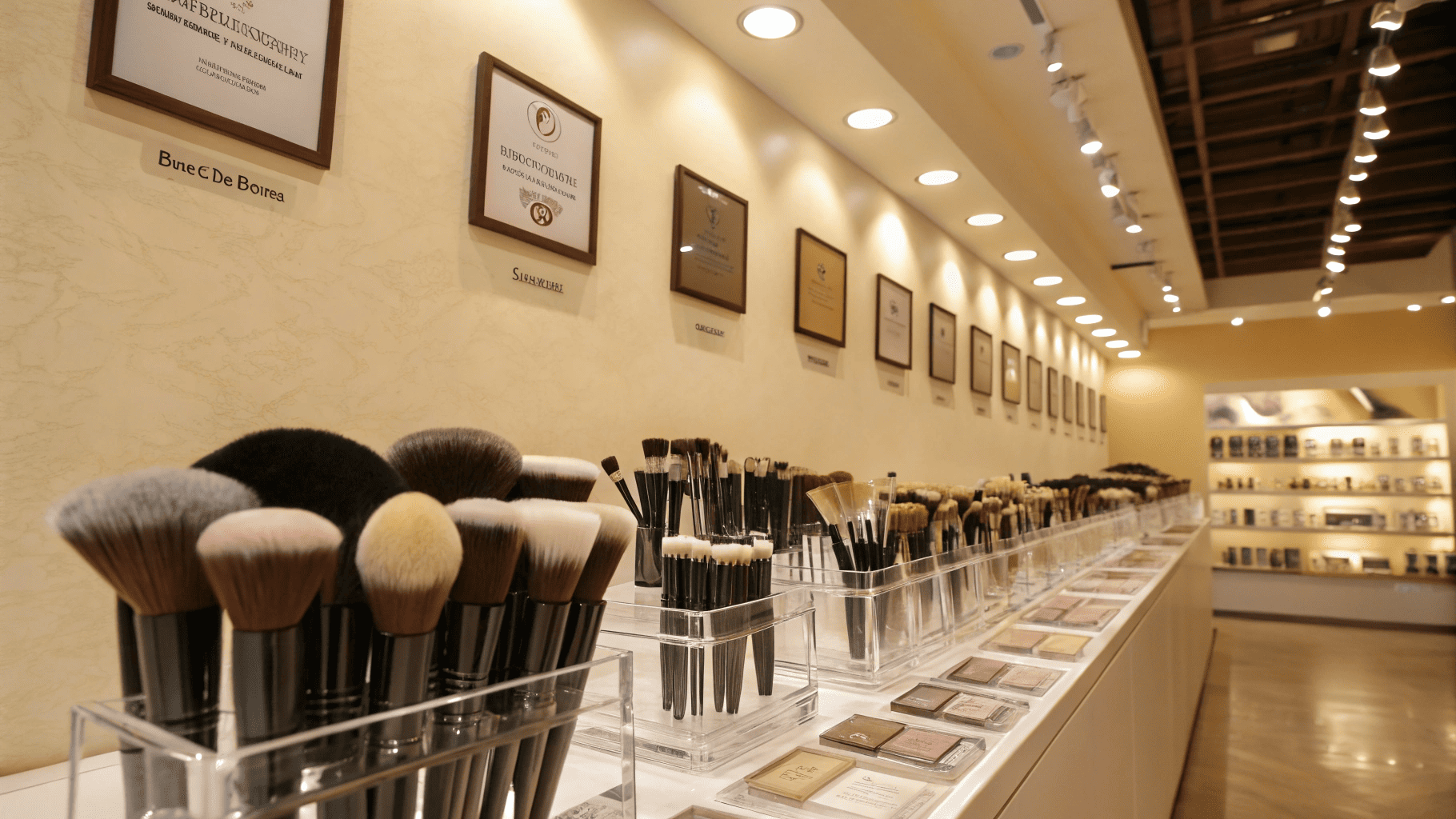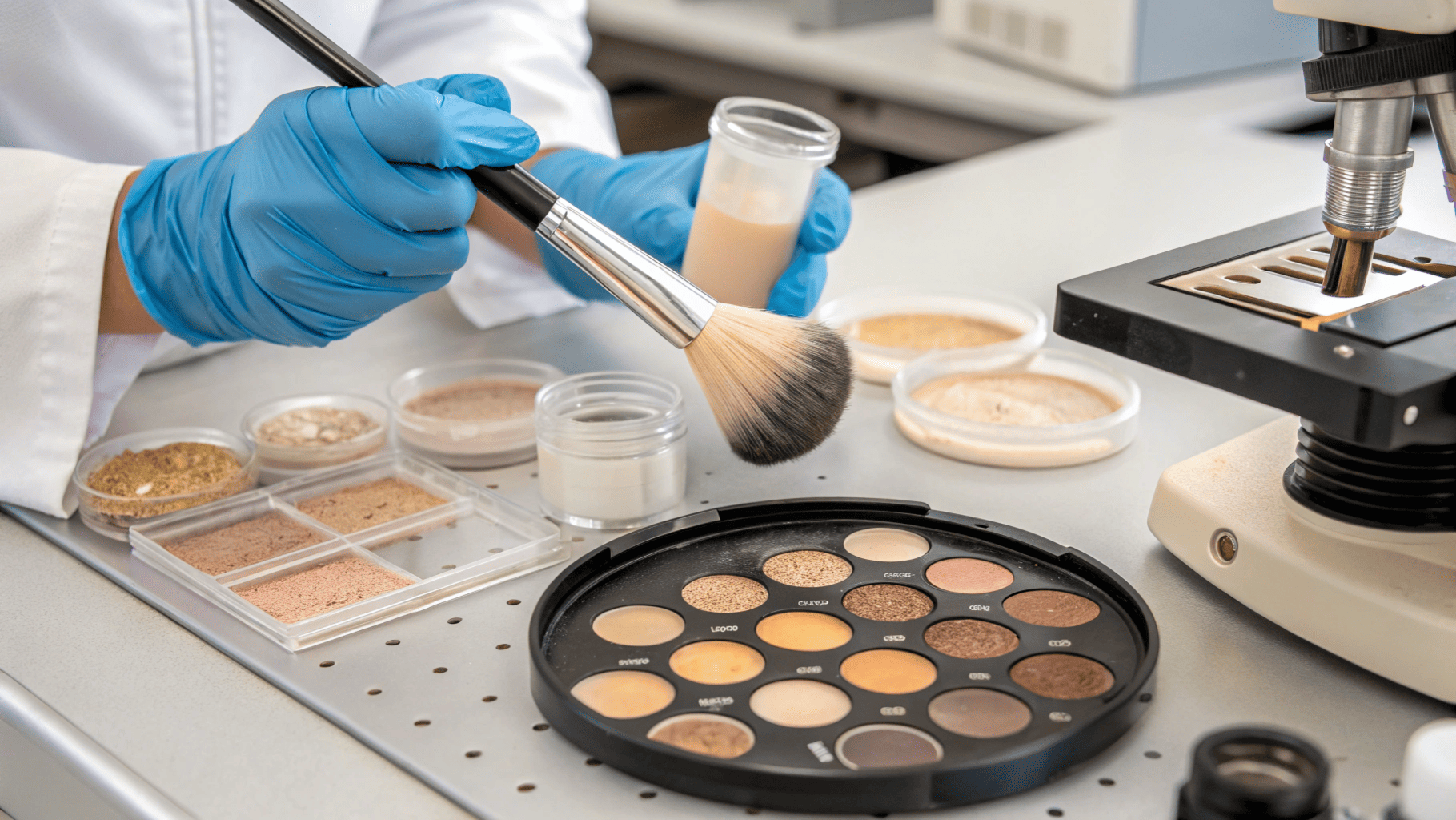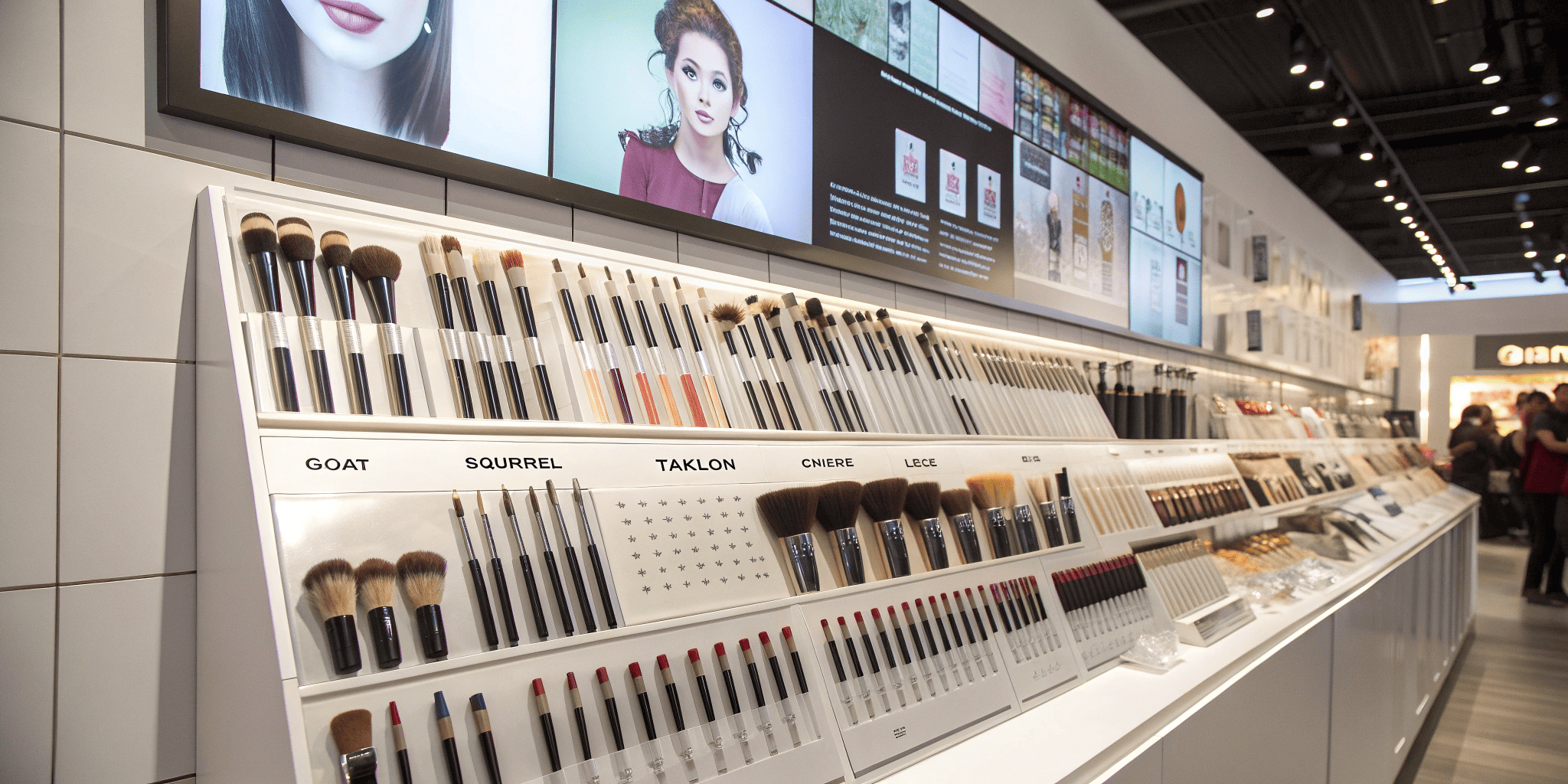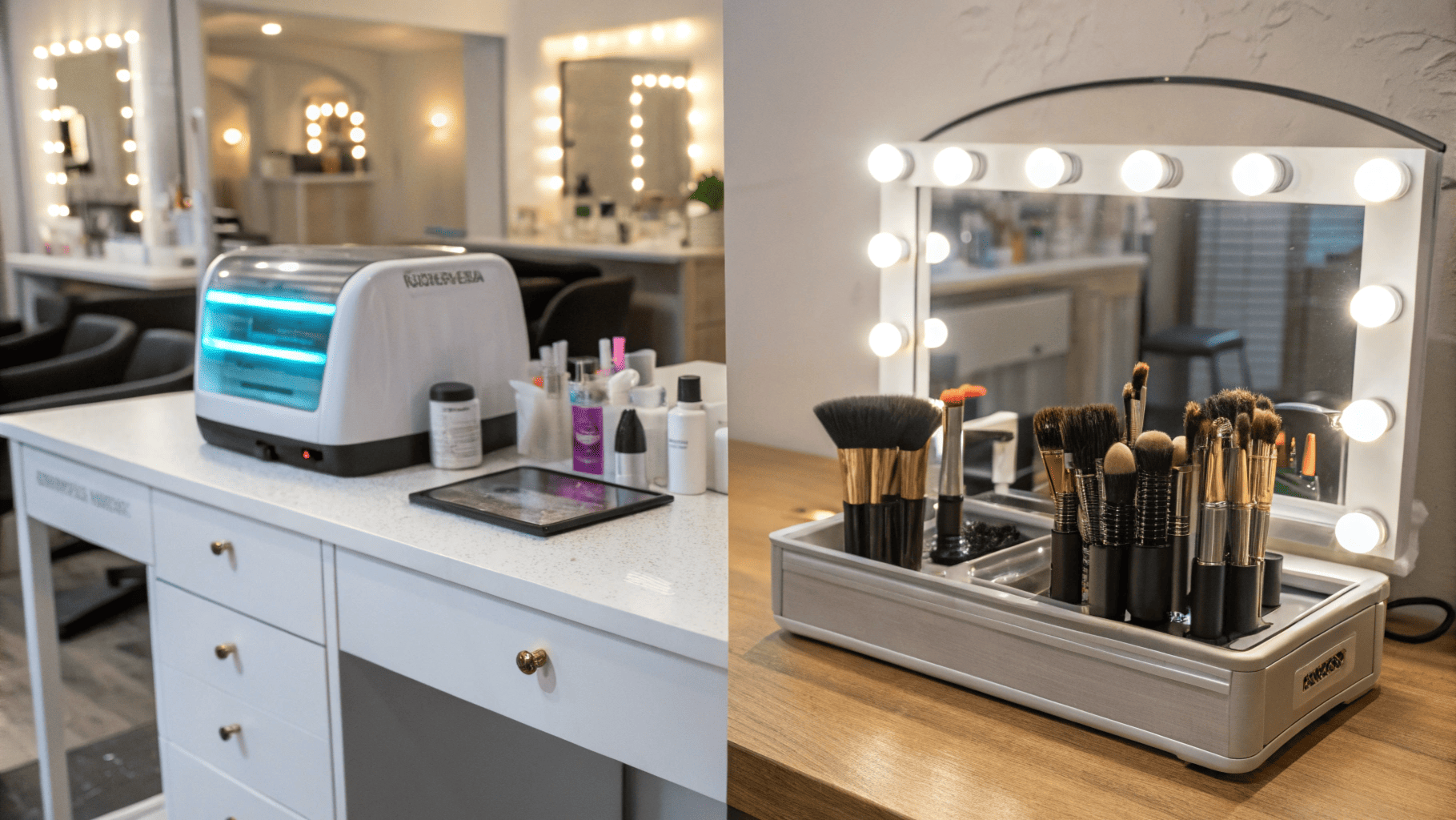One clean beauty founder ordered “vegan” brushes—only to find out they contained goat hair. She pulled 2,000 units and delayed launch. That day, we learned: brush hair isn’t just material—it’s brand trust.
The best material for makeup brushes depends on your product formula, user expectations, and brand values. Natural hair is great for powders. Synthetic bristles are ideal for creams, liquids, and cruelty-free claims. But the real answer? It depends on who you’re making it for.

Professional makeup brush showroom display
Brush hair choice directly impacts product payoff, hygiene, shelf appeal, and even refund rate. Let’s break down each option—and how to choose the right one for your brand.
What Material Are the Best Makeup Brushes Made Of?
Makeup brushes are made from either natural hair1 (like goat, squirrel, pony), synthetic fibers (like PBT2, nylon, or taklon), or blends of both. Each has different properties in how they hold, transfer, and diffuse product.

Here’s a quick comparison:
| Bristle Type | Source | Best For | Texture & Feel | Key Consideration |
|---|---|---|---|---|
| Goat Hair | Natural | Powder foundation, blush | Firm, slightly porous | Not vegan, sheds if untreated |
| Squirrel Hair | Natural | Blending eyeshadow, highlight | Ultra-soft | Expensive, delicate |
| Pony Hair | Natural | Versatile powders | Balanced softness | Coarser than goat |
| PBT | Synthetic (DuPont™3) | Liquids, foundations | Smooth, holds shape well | Most common for OEM |
| Taklon | Synthetic | Concealers, cream eyeshadow | Soft, flexible | Mimics animal softness |
| Nylon | Synthetic | Detail brushes, eyeliner | Firm and precise | Can feel stiff if cheap |
PBT, especially those sourced from DuPont™3, is increasingly becoming the gold standard in private label production because of its shape retention, skin feel, and compatibility with vegan claims.
What Is the Best Material for Face Brushes?
This depends on the product formula and user expectations. Natural hair is preferred for powders. Synthetic is better for creams, foundations, and hygiene.

Let’s match based on application:
| Product Type | Best Bristle Type | Why It Works |
|---|---|---|
| Powder Foundation | Goat, Squirrel | Picks up and diffuses powder evenly |
| Liquid Foundation | PBT, Taklon4 | Non-absorbent, hygienic, smooth |
| Cream Blush | Synthetic5 (firm) | Holds shape, easy to clean |
| Eyeshadow (matte) | Squirrel, Pony | Soft blending without harsh lines |
| Eyeliner / Brow Gel | Nylon | Precise, non-bending fibers |
Natural hair6 may still outperform synthetics for powder blending due to its microscopic cuticle structure, which grips powder and releases it gradually. But modern synthetics are catching up fast—and outperform in consistency, cost-efficiency, and ethical alignment.
Which Is Better, Synthetic or Natural Makeup Brushes?
There is no one-size-fits-all answer. Synthetic brushes are better for liquids and ethical claims. Natural ones still excel with powders. Your brand promise should guide your choice.

Here’s a direct comparison:
| Factor | Natural Hair | Synthetic Fiber |
|---|---|---|
| Powder pickup | ✅ Excellent | ⚠️ Moderate |
| Cream/Liquid application | ⚠️ Absorbs | ✅ Clean, efficient |
| Cleaning ease | ⚠️ Needs care | ✅ Easy |
| Vegan/ethical claims | ❌ No | ✅ Yes |
| Salon hygiene | ⚠️ Porous | ✅ Sterilizable |
| Batch consistency | ❌ Variable | ✅ High |
If you’re building a vegan or clean beauty line7, synthetic PBT or Taklon is your safest option. If you’re catering to pro MUA8 or heritage luxury markets, high-end goat or squirrel may still appeal—though even pros now increasingly prefer synthetic for hygiene and ease.
What Are the Best Makeup Brushes Out There?
The best brushes aren’t just about bristle type—they balance application quality, hygiene, ethics, and post-sale reliability.

Here’s why brush material matters beyond makeup:
- Salon use: PBT resists alcohol and UV disinfection better than natural hair.
- Sensitive skin: Nylon and Taklon are hypoallergenic and non-porous.
- Retail returns: Synthetic brushes reduce complaints about shedding or product buildup.
- Brand trust: Offering true vegan claims helps prevent refund claims or negative reviews.
According to Mintel’s Clean Beauty Consumer Report 2025, over 60% of Gen Z shoppers prefer vegan-certified tools, even when the performance is similar. And as L’Oréal’s 2024 ESG Roadmap states, more global brands are phasing out animal-based brushes entirely.
We’ve helped many brands pivot toward PBT-based brushes without changing design or price—only material. In return, they gained certification, better DTC9 reviews, and fewer logistics headaches.
Conclusion
Choosing the right brush material doesn’t just affect makeup—it shapes your brand’s reputation. If you’re unsure where to start, I’m happy to help you match your brush materials to your formula, audience, and claims—so your product works, sells, and builds trust.
-
Understanding the differences can help you choose the right brushes for your makeup needs, enhancing your application experience. ↩
-
Explore the advantages of PBT brushes, known for their shape retention and skin feel, making them ideal for various makeup applications. ↩
-
Explore this link to understand how DuPont™ enhances makeup brush quality and performance, ensuring a better application experience. ↩ ↩
-
Explore this link to understand why Taklon is favored for its hygiene and performance in makeup application. ↩
-
Learn why synthetic brushes are preferred for cream products, focusing on hygiene and application efficiency. ↩
-
Explore the advantages of natural hair brushes for makeup application, including their unique ability to blend powders effectively. ↩
-
Learn how to create a successful vegan beauty line, focusing on materials and consumer preferences. ↩
-
Understanding MUA (Makeup Artist) roles can enhance your knowledge of makeup application and industry standards. ↩
-
Understanding DTC (Direct-to-Consumer) strategies can enhance your brand’s approach to customer engagement and sales. ↩

